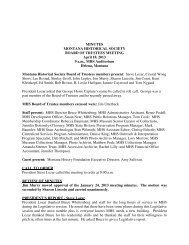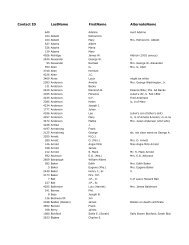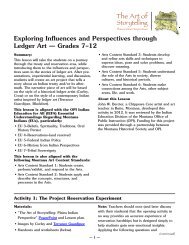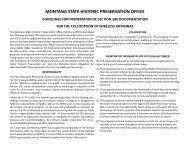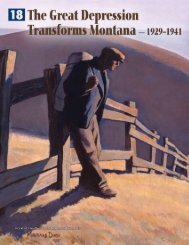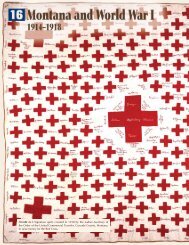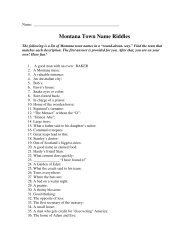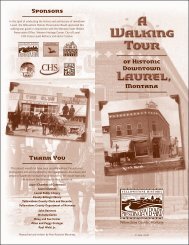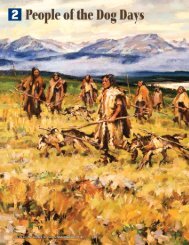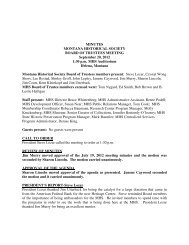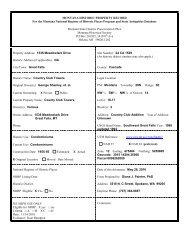Chapter 15 - Montana Historical Society
Chapter 15 - Montana Historical Society
Chapter 15 - Montana Historical Society
Create successful ePaper yourself
Turn your PDF publications into a flip-book with our unique Google optimized e-Paper software.
FIGURE <strong>15</strong>.1: Detail from <strong>Montana</strong>: A Buried History, by James Todd, 1976
Read To Find ouT:<br />
n How industrialization affected the<br />
way people lived and worked<br />
n What problems industrialization<br />
caused in <strong>Montana</strong><br />
n What made people demand change<br />
n Which changes helped—and which<br />
did not work at all<br />
The Big Picture<br />
Industrialization gave big companies control over life and<br />
politics in many ways. During the Progressive Era, people<br />
worked together to limit the control corporations had and<br />
to solve problems in their society.<br />
if you could change society for the better, what would you want to<br />
change? How would you go about working for that change?<br />
At the dawn of the twentieth century, people across the country saw<br />
many problems in their society. They saw poverty and disease. They<br />
saw people working in unsafe conditions just to make a living. They<br />
saw families crowded in slums with bad water, rats, bugs, and other<br />
threats to public health. They also saw political and economic power<br />
concentrated in the hands of a very few wealthy men.<br />
They realized these problems dragged all of society down. They<br />
wanted healthier cities and safer working conditions. They believed that<br />
America’s democracy would work better if citizens had more political<br />
power. So they worked for political, social, and economic change.<br />
This period became known as the Progressive Era. Progressivism<br />
started at the local level as people organized to work for change. They<br />
got involved with their church groups, civic clubs, labor unions<br />
(organizations of employees that bargain with employers), and<br />
women’s clubs. They wrote letters, gave talks, and led marches to publicize<br />
their ideas. They raised money to build libraries and city parks. They<br />
helped pass new laws to protect worker’s safety and public health.<br />
Nationally, the Progressive Era did not last long—from about 1900<br />
until 1917, when the United States joined World War I. In <strong>Montana</strong>, it<br />
lasted longer—until the mid-1920s—and had a profound (important)<br />
effect on everyday life. Though some Progressive movements failed, others<br />
became so important that it is hard to imagine life without them.<br />
2 9 1
FIGURE <strong>15</strong>.2: Smoke from the smelters<br />
darkened the skies and killed plants and<br />
wildlife near industrial sites. But it also<br />
symbolized employment to people who<br />
needed to earn a living.<br />
1900–17<br />
<strong>Montana</strong><br />
homestead boom<br />
1908<br />
Model T invented<br />
America Transformed<br />
To many people, the dawn of the twentieth century felt like a new era.<br />
Their lives were changing fast. Industrialization (rapid development<br />
of industry brought about by the introduction of machinery) had swept<br />
across North America in the late 1800s. It brought new conveniences<br />
like electric lights, and labor-saving devices like washing machines<br />
and typewriters.<br />
Many people felt hopeful and excited. New technologies like X-rays<br />
and electric batteries improved people’s lives. New scientifi c discoveries<br />
like Einstein’s theory of relativity and the discovery of the atom<br />
led many people to believe that the world was understandable. They<br />
also thought that experts could apply science and technology to solve<br />
social problems.<br />
1910<br />
More than a quarter of<br />
<strong>Montana</strong>’s population<br />
is foreign born<br />
1906<br />
<strong>Montana</strong> adopts<br />
the initiative and<br />
the referendum<br />
1907<br />
<strong>Montana</strong> establishes<br />
juvenile court system<br />
1909<br />
1907–34 Missoula free speech fi ght<br />
292 Reservations face allotment<br />
2 9 2 P A R T 3 : W A V E S O F D E V E L O P M E N T<br />
1914–18<br />
World War I<br />
19<strong>15</strong><br />
Nonpartisan<br />
League<br />
founded<br />
1914<br />
<strong>Montana</strong> women<br />
get the right to vote<br />
Problems of the<br />
Industrial Revolution<br />
Yet industrialization had a dark side.<br />
The factories that produced modern<br />
conveniences relied on an almost<br />
endless supply of cheap labor. In the<br />
eastern United States, men, women,<br />
and children labored 14-hour days<br />
operating dangerous machines in<br />
unheated workrooms. In <strong>Montana</strong>,<br />
workers toiled in mines, smelters,<br />
and timber camps to provide the raw<br />
materials eastern factories needed to<br />
operate. Their jobs were dangerous,<br />
too, and many people were injured or<br />
killed in industrial accidents.<br />
Many of these workers were immigrants.<br />
Between 1900 and 19<strong>15</strong> about<br />
<strong>15</strong> million immigrants arrived in the<br />
1916<br />
<strong>Montana</strong> passes<br />
Prohibition<br />
1916<br />
Jeannette Rankin<br />
is elected to the<br />
U.S. Congress<br />
1914–21<br />
Troops occupy<br />
Butte six times<br />
in response<br />
to labor unrest<br />
1916<br />
Rocky Boy’s Reservation<br />
created for Chippewa-Cree<br />
1910–25<br />
<strong>Montana</strong>ns create 28 new counties<br />
1917<br />
Speculator Mine<br />
disaster<br />
1900 1910 1914 19<strong>15</strong> 1916 1917 1918<br />
1918<br />
Worldwide infl uenza epidemic
United States—more than all of the immigrants in<br />
the previous 40 years.<br />
Millions of these new immigrants came from<br />
non-English-speaking countries. Their customs,<br />
traditions, and religions were different from mainstream<br />
(majority) America’s. Even though most<br />
people’s families had immigrated to the United<br />
States only a few generations earlier, many Americans worried about<br />
how these newcomers would change the country.<br />
Cities swelled with slums where the workers lived. Families crowded<br />
together in apartments; children played in streets and alleyways and<br />
were constantly exposed to health hazards. Factories spewed (spit out)<br />
smoke, soot, and other pollutants into the air and the rivers. In <strong>Montana</strong>,<br />
pollution from smelters killed off wildlife, livestock, trees, and crops for<br />
miles around the smelters—and made many people sick.<br />
Meanwhile, a few men grew very rich, and the corporations they<br />
owned grew large and powerful.<br />
<strong>Montana</strong>: Under the Thumb of the Company<br />
By 1900 many <strong>Montana</strong>ns lived in the grip<br />
of a few large copper, lumber, and railroad<br />
corporations, all run by a handful of men<br />
(see <strong>Chapter</strong> 10). The most powerful was<br />
the Anaconda Copper Mining Company—<br />
known by everyone as simply “the Company.”<br />
With interests in railroads, lumber, and electric<br />
power, Anaconda wielded almost total<br />
control over <strong>Montana</strong>. It employed a large<br />
number of people. It manipulated (controlled<br />
in a devious way) many of the state’s<br />
businesses as well as the <strong>Montana</strong> legislature<br />
(the branch of government that passes<br />
laws). It also owned most of the state’s newspapers,<br />
so it controlled public opinion.<br />
1918<br />
<strong>Montana</strong> Sedition<br />
Law passed<br />
1919<br />
1919–25<br />
Half of <strong>Montana</strong><br />
farmers lose<br />
their land<br />
1920<br />
19th Amendment to the U.S. Constitution<br />
gives women the right to vote<br />
1919<br />
18th Amendment to the U.S. Constitution<br />
establishes Prohibition<br />
“<br />
Anaconda ran it all—the railroads, the<br />
ranchers, the power company, the<br />
newspapers, the miners, everything.<br />
They had iron control.<br />
”<br />
—MONTANA HISTORIAN HARRY FRITZ<br />
1924<br />
Congress passes the<br />
Indian Citizenship Act<br />
1933<br />
18th Amendment to the U.S. Constitution<br />
repealed, ending Prohibition<br />
1920 1921 1922 1923 1924 1925<br />
FIGURE <strong>15</strong>.3: Political cartoons were—<br />
and still are—a popular way of expressing<br />
opinions about current events. This<br />
cartoon, published in the Butte Daily<br />
Bulletin in 1920, shows how some<br />
people viewed the Anaconda Copper<br />
Mining Company’s role in <strong>Montana</strong>.<br />
1924<br />
<strong>Montana</strong>ns pass initiative<br />
increasing tax on mines<br />
1935<br />
293<br />
1 3 — H O M E S T E A D I N G T H I S D R Y L A N D 2 9 3
FIGURE <strong>15</strong>.4: Progressives believed that<br />
the initiative and referendum could<br />
empower ordinary <strong>Montana</strong>ns. This<br />
cartoon shows a farmer strapping on<br />
two boxing gloves—labeled “initiative”<br />
and “referendum”—to learn self-defense<br />
skills, while a man labeled “Big Biz”<br />
(for big business) looks on in alarm.<br />
The cartoon was titled “Training for<br />
the Summer Scrap [fi ght].”<br />
2 9 4 P A R T 3 : W A V E S O F D E V E L O P M E N T<br />
Political Reforms: Power to the People<br />
Progressives believed that corporations like the Anaconda Copper Mining<br />
Company had too much control over government—and that ordinary<br />
people did not have enough. So they pushed for political reforms to give<br />
voters more political power. Because of these reforms, you will have a<br />
stronger voice in government than your ancestors had in 1900.<br />
• The initiative. Passed in 1906, the initiative allows voters to establish<br />
and pass laws they want, even if the legislature refuses to pass<br />
them. If citizens collect a certain number of signatures, an initiative<br />
can be put on the general ballot for people to vote on.<br />
• The referendum. The referendum (also passed in 1906) works the<br />
same way as the initiative but allows voters to repeal (cancel) laws<br />
passed by the legislature that the people do not want.<br />
• Direct election of senators. In the nineteenth century the<br />
legislatures—not the people—elected U.S. senators. Copper king<br />
William A. Clark caused a nationwide outrage when he bribed<br />
(offered illegal payments to) legislators to elect him to the U.S. Senate<br />
(see <strong>Chapter</strong> 10). In 1911 the <strong>Montana</strong> legislature passed a law<br />
allowing <strong>Montana</strong>ns to choose their own senators. In 1912 the<br />
U.S. Congress passed the 17th Amendment to the U.S. Constitution,<br />
giving voters nationwide the right to elect U.S. senators.<br />
• Primary elections. Powerful corporate owners<br />
often controlled political parties. In <strong>Montana</strong>,<br />
the Company decided who could run for public<br />
offi ce. Progressives wanted to give voters more<br />
say in who the candidates would be. So they<br />
proposed an initiative in 1912 to institute primary<br />
elections. Primary elections let voters choose the<br />
candidates to run in the general election.<br />
1914: Women Get the Vote<br />
Many homesteaders and immigrants who came<br />
to <strong>Montana</strong> after 1900 believed that women were<br />
more virtuous (morally good) than men. They<br />
thought that if women could vote, they would<br />
use their moral superiority to end political corruption<br />
and improve society. That is why many<br />
Progressives supported women’s suffrage (the<br />
right to vote).<br />
A young Missoula woman named Jeannette<br />
Rankin led the charge for women’s suffrage in<br />
<strong>Montana</strong>. Rankin traveled to almost every corner<br />
of the state, speaking at rallies, holding meetings,<br />
and talking to newspaper editors, trying to
convince them to support women’s<br />
suffrage. In 1911 Rankin gave a speech<br />
to legislators in the <strong>Montana</strong> House<br />
of Representatives, where no woman<br />
had been allowed to speak before.<br />
Other <strong>Montana</strong> women who fought<br />
for suffrage sat beside her—Mary<br />
Long Alderson, Dr. Maria Dean, and<br />
Dr. Mary Moore Atwater. When she<br />
fi nished talking, the legislators gave her<br />
a standing ovation.<br />
Finally, in 1914, <strong>Montana</strong>’s male<br />
voters amended the state constitution<br />
(a document that sets rules for<br />
government) to give women the vote. Six years later, in 1920,<br />
U.S. voters gave all women in the country the right to vote.<br />
1916: First Woman in Congress<br />
In 1916 <strong>Montana</strong>ns elected Jeannette<br />
Rankin to Congress—and became the fi rst<br />
state to send a woman to Washington, D.C.<br />
People watched her closely to see whether<br />
a woman could hold her own in national<br />
politics. Rankin quickly proved that she<br />
could. In fact, she immediately made a big<br />
stir by speaking out against World War I<br />
(see <strong>Chapter</strong> 16).<br />
The 1916 election also put two women<br />
in the <strong>Montana</strong> legislature: Maggie Smith<br />
Hathaway, a Democrat from Ravalli<br />
County, and Emma J. Ingalls, a Republican<br />
newspaper publisher from Flathead<br />
County. By 1920 Hathaway had become a<br />
powerful leader in state politics.<br />
County-Busting for<br />
Better Citizenship<br />
One Progressive idea changed the map of<br />
<strong>Montana</strong> by splitting big eastern counties<br />
into smaller ones. As the homesteaders<br />
peopled more of <strong>Montana</strong>, they wanted<br />
to be more involved in local politics, so<br />
they wanted their county seats closer. And<br />
eastern farmers knew that having more,<br />
“<br />
Men want women in the home and they<br />
want them to make the home perfect. Yet<br />
how can women make it perfect if they have<br />
no control over the infl uences on the home?<br />
It is beautiful and right that a mother should<br />
nurse her child through typhoid fever. But<br />
it is also beautiful and right that she should<br />
have a voice in regulating the milk supply<br />
from which the typhoid came.<br />
”<br />
—SUFFRAGIST JEANNETTE RANKIN, ADDRESSING THE MONTANA LEGISLATURE,<br />
FEBRUARY 1, 1911<br />
Jeannette Rankin<br />
Jeannette Rankin was born in<br />
Missoula in 1880. She graduated<br />
from the University of <strong>Montana</strong> in<br />
1902 with a degree in biology. On<br />
a trip to Boston in 1904, she saw<br />
people living in slums, suffering<br />
from poverty. She became a social<br />
worker and joined the campaign<br />
for women’s suffrage. She believed that if women could<br />
vote, they would solve many social problems like poverty<br />
and child labor.<br />
In 1914 Rankin returned to <strong>Montana</strong> to help lead the<br />
fight for women’s suffrage. In 1916 she ran for the U.S.<br />
Congress as a Republican and became the first woman<br />
ever elected to Congress. On her fourth day in office, she<br />
voted against entering World War I. This so enraged voters<br />
that she was not reelected. For the next 20 years she<br />
worked for peace, labor reforms, and child labor laws.<br />
In 1939 Rankin again ran for Congress. This time she<br />
hoped to help keep the United States out of World War II.<br />
Once again, she cast a controversial vote against going to<br />
war, even though she knew it would keep her from being<br />
reelected. For the rest of her life Rankin worked for peace.<br />
1 5 — P R O G R E S S I V E M O N T A N A 2 9 5
FIGURE <strong>15</strong>.5: Towns competed for county<br />
seats because county governments<br />
brought jobs, prosperity, and stability<br />
to new communities. In 1913 Ekalaka<br />
competed to become the county seat of<br />
Fallon County. It lost to Baker—but later<br />
became the seat of Carter County.<br />
FIGURE <strong>15</strong>.6: Miners set dynamite to<br />
loosen underground rock. They had to<br />
fi gure out how to blast just enough rock<br />
to keep up production without causing a<br />
cave-in—which inevitably killed people.<br />
2 9 6 P A R T 3 : W A V E S O F D E V E L O P M E N T<br />
smaller counties would give them a stronger voice in the state legislature<br />
because each county had one state senator. (This changed in the 1960s.)<br />
In 19<strong>15</strong> the <strong>Montana</strong> legislature passed a law allowing people to<br />
redraw their county lines by submitting a petition to the state. In the<br />
next few years, <strong>Montana</strong>’s 27 counties split into 56 smaller counties.<br />
Splitting up counties was called “county-busting.”<br />
Many small counties in eastern <strong>Montana</strong> struggle today with the<br />
aftereffects of the Progressive Era county-busting craze. Of the 56<br />
counties in the state, 22 have fewer than 5,000 people. Thirteen counties<br />
have fewer than 2,000 people; Petroleum County has only 474. Nearly<br />
every legislature since 1936 has considered consolidating (combining<br />
several into one) some of these counties, but these measures have failed<br />
because citizens want to keep their county seats.<br />
Labor Reform:<br />
Workers Unite for Better Conditions<br />
<strong>Montana</strong>’s mines, lumber mills, and railroads all ran on the labor of<br />
working people. Working men prided themselves on the skill they<br />
brought to dangerous, diffi cult work. Yet, as demand for <strong>Montana</strong>’s<br />
resources intensifi ed, the pace of production quickened. Industrial work<br />
became even more dangerous.<br />
The mines and sawmills hired more unskilled laborers. Many of them<br />
were immigrants who spoke little English. They did not understand the<br />
instructions—or warnings—that more<br />
experienced workers gave them.<br />
New mining methods using dynamite,<br />
machine drills, and steampowered<br />
hoists (devices for lifting)<br />
increased productivity. But they also<br />
made accidents more frequent and<br />
more deadly. By 1908 mining had the<br />
highest fatality rate of any industry in<br />
the nation. Mining, railroad work, and<br />
logging were all more likely to kill a<br />
man than going to war.<br />
If laborers could not work, their<br />
families went hungry. If they spoke out<br />
against their working conditions, they<br />
got fi red—there were always plenty<br />
of other men looking for jobs. If they<br />
went on strike (an organized protest<br />
in which workers refuse to work) or<br />
protested, the Company simply had the<br />
governor call in armed troops.
In the height of the Progressive Era, labor unions and Progressive politicians<br />
worked together to improve workplace safety. They backed laws<br />
establishing the minimum wage, the eight-hour workday, and a worker’s<br />
compensation program to give aid to workers injured on the job.<br />
Farmers Organized, Too<br />
In eastern <strong>Montana</strong>, farmers also called for reforms. Farmers paid high<br />
transportation prices to ship their products to market, while mines and<br />
lumber mills—which had close ties to the railroads—shipped their products<br />
at discount rates.<br />
Some farmers formed local cooperatives to market produce (farm<br />
products) and to negotiate lower rail rates. They demanded that the state<br />
regulate railroads in <strong>Montana</strong> to make sure rates were fair and honest.<br />
In 1907 the state legislature created a <strong>Montana</strong> Railroad Commission,<br />
which in 1913 became the <strong>Montana</strong> Public Service Commission. This<br />
commission oversees all public transportation carriers and the electrical<br />
utilities to make sure consumers are treated fairly.<br />
Social Reforms:<br />
Efforts to Improve <strong>Society</strong><br />
Disease, diarrhea, and infection were part of everyday life in the<br />
early 1900s. People lived and worked close together with inadequate<br />
sewers and polluted drinking water. Industries polluted<br />
the water and air, but towns caused pollution, too. Many towns<br />
dumped their garbage at the city’s edge, where fl ies picked up<br />
germs and spread them. People emptied spittoons (containers<br />
for spitting tobacco), garbage, kitchen slop, and chamber pots<br />
into rivers or in a hole in the ground. Horses and mules that<br />
worked in the towns and mines created tremendous amounts<br />
of manure.<br />
Without proper sanitation,<br />
diseases spread rapidly. Small-<br />
pox, cholera, diphtheria,<br />
typhoid, and tuberculosis<br />
killed many people.<br />
In 1907 the <strong>Montana</strong> legislature<br />
made it illegal for cities to<br />
dump raw sewage into rivers<br />
that people used for drinking<br />
water. The law was one of the<br />
fi rst clean-water acts passed in<br />
the country.<br />
Progressives also helped<br />
create a state board of health.<br />
“Life Was Pretty Cheap”<br />
“Life was pretty cheap for the money<br />
that some of these companies were<br />
making . . . A lot of broken legs and<br />
broken backs. If they got cut on<br />
the head, the doctor used to just<br />
shave around the wound and put the<br />
stitches in and then put this cone on<br />
the wound—it would foam and turn<br />
hard. And then the miner’d go to<br />
work the next day.”<br />
—DENNIS “DINNY” MURPHY, BUTTE MINER<br />
How Much Is a Leg Worth?<br />
“My dad was hurt in the mine here in Red Lodge and had to have<br />
his leg amputated in 1912, which was the same year I was born. The<br />
coal fell on his foot and crushed it. He got gangrene from that . . .<br />
They paid his hospital bill, and he had an artificial limb that every<br />
now and then would wear out because they had leather tops that<br />
would split. He would have to get another limb which they [the<br />
mining company] paid about half, but that’s about all. He never<br />
did get compensation for anything else.”<br />
—DAISY PEKICH LAZETICH, A RED LODGE MINER’S DAUGHTER<br />
1 5 — P R O G R E S S I V E M O N T A N A 2 9 7
“<br />
Where the Poor Lived<br />
“No. 22 Corra Terrace: 4 people one<br />
bed room . . . toilet outside, sewage<br />
disposed of in Cess Pool, own cow,<br />
never disinfected, very dirty house,<br />
cow pen at back door, many flies, no<br />
screens, pipes in sink leaking and water<br />
dripping from side of house.”<br />
—SILVER BOW COUNTY HEALTH OFFICIAL’S<br />
REPORT ON LIVING CONDITIONS IN BUTTE<br />
NEIGHBORHOODS, 1912<br />
2 9 8 P A R T 3 : W A V E S O F D E V E L O P M E N T<br />
They thought experts could apply scientifi c principles to reduce<br />
the spread of diseases. They established a state hospital to treat<br />
tuberculosis patients. They also got the state to set up agencies<br />
to inspect milk and meat products to make sure that the food<br />
people bought was safe.<br />
Reducing Child Labor<br />
Tuberculosis germs . . . grow in men, and<br />
men spit them out on the streets, on the<br />
fl oors, on the carpets. When these men (and<br />
women and children) learn to spit only in<br />
proper places this source of the disease will<br />
be eradicated [stamped out].<br />
”<br />
—DR. THOMAS D. TUTTLE, HEALTH OFFICER FOR THE MONTANA BOARD OF HEALTH<br />
Imagine waking up every morning at dawn and running down<br />
to the mine for a 12-hour workday picking coal, mucking<br />
(cleaning) stables, or cleaning tools. Your lungs fi ll with mine<br />
dust. You must constantly watch out for heavy, dangerous<br />
equipment. You work hard because your widowed mother<br />
relies on your income to survive. You earn a dollar a day.<br />
Industrial accidents left many<br />
women widows, and children often<br />
had to leave school to help support<br />
their families. Young boys worked as<br />
nippers (errand boys who fetched<br />
tools, tended mules, and did other odd<br />
jobs for the mines). They also worked<br />
as newsboys, chimneysweeps, carpenter’s<br />
helpers, messengers, shoe shiners,<br />
and peddlers (people who sell things<br />
door-to-door). Girls often worked as<br />
servants for wealthy families.<br />
In 1904 <strong>Montana</strong> voters passed a<br />
constitutional amendment (a change<br />
to the constitution) setting age 16 as<br />
the minimum age for employment in<br />
the mines—and age 14 for other jobs.<br />
Farm and ranch children worked hard,<br />
too—tending animals, operating farm<br />
equipment, chopping fi rewood, and<br />
fetching water. But because so many<br />
homesteaders relied on the labor of<br />
FIGURE <strong>15</strong>.7: Where did miners go to the<br />
bathroom? Covered toilet cars like this<br />
one provided a place on every level of the<br />
mine. When full, they had to be hauled<br />
up to ground level and emptied. These<br />
covered toilets were a big improvement<br />
over nothing at all. When mines started<br />
using covered toilet cars, fewer miners<br />
got sick from infectious diseases.
their children, the child-labor<br />
laws did not apply to farms.<br />
A few years later the legislature<br />
passed a law requiring<br />
children to attend school until<br />
age 16. Together these two<br />
laws helped make sure that<br />
<strong>Montana</strong>’s youth had an<br />
opportunity for a healthy childhood<br />
and a basic education.<br />
A Special Court for Kids<br />
In 1903 a 14-year-old boy named<br />
Harry Anderson burned down<br />
the <strong>Montana</strong> Club, a prominent<br />
Helena building. Harry liked<br />
to set fi res, ring the fi re alarms,<br />
and then be part of the rescue<br />
effort alongside fi refi ghters.<br />
Young Harry quickly confessed<br />
to setting the fi re. He was accused of arson and probably would<br />
have gone to the state prison. But a progressive attorney named Thomas<br />
J. Walsh served as Harry’s defense lawyer at no charge. Walsh knew<br />
Harry’s father, a bartender at the <strong>Montana</strong> Club. Walsh convinced the<br />
judge to send Harry to the Pine Hills Youth Correctional Center, in Miles<br />
City, instead of to prison. Before this, anyone who committed a serious<br />
crime—no matter how young—could be sentenced to the <strong>Montana</strong><br />
State Prison.<br />
The idea of treating children differently than adults was a Progressive<br />
Era idea. A few years later lawmakers created a juvenile court system,<br />
guaranteeing that children who got in trouble with the law would no<br />
longer be treated the same as criminal adults.<br />
Prohibition: A Reform That Failed<br />
One Progressive Era reform failed dismally: Prohibition (a movement<br />
to outlaw alcohol). Many Progressives saw the damage that alcoholism<br />
wreaked on people, families, and society. They hoped that outlawing<br />
alcohol would make society better.<br />
In 1916 <strong>Montana</strong>ns passed a Prohibition referendum making it illegal<br />
to drink, serve, or make alcoholic beverages. In 1919 Prohibition became<br />
the law of the United States through the 18th Amendment to the U.S.<br />
Constitution.<br />
But people did not stop drinking alcohol; they just drank in secret.<br />
Bootleg (illegal) alcohol became a huge, profi table business. Whiskey<br />
FIGURE <strong>15</strong>.8: These young boys worked<br />
with Butte’s Blacksmith Union, laboring<br />
alongside the men. The union members<br />
taught the boys skills of the trade and<br />
watched out for their safety when they<br />
could.<br />
1 5 — P R O G R E S S I V E M O N T A N A 2 9 9
FIGURE <strong>15</strong>.9: Carbon County sheriff<br />
George Boggs (left) and county attorney<br />
Rudolph Nelstead (right) bust up<br />
a homemade still (alcohol distillery) in<br />
1919. Prohibition was an attempt to<br />
remove alcoholism, drunkenness, and<br />
other problems from society. It also<br />
created a cash industry—bootlegging—<br />
for some struggling <strong>Montana</strong> families.<br />
FIGURE <strong>15</strong>.10: Socialists across the<br />
United States wore political buttons<br />
like this one. Butte was one of many<br />
American cities to elect a Socialist<br />
mayor in the early 1900s.<br />
3 0 0 P A R T 3 : W A V E S O F D E V E L O P M E N T<br />
runners smuggled liquor into the<br />
United States from Canada. Farmers set<br />
up hidden distilleries to make alcohol.<br />
Across the country, bootleggers<br />
built an effi cient transportation and<br />
communications network to funnel<br />
alcohol to the big cities. Some focused<br />
on the open country between the<br />
Hi-line and Canada, where it was easy<br />
to hide from the law. After a serious<br />
drought hit in 1917 (see <strong>Chapter</strong><br />
13), many families in farm towns like<br />
Havre and Plentywood helped transport<br />
liquor for the bootleggers because<br />
they paid in cash. Helping bootleggers<br />
was one way to earn money when the<br />
crops failed.<br />
Prohibition ended in failure. Instead of improving morals, it only<br />
encouraged people to break the law. The <strong>Montana</strong> legislature repealed<br />
its Prohibition law in 1926, and Congress repealed the 18th Amendment<br />
in 1933. Even <strong>Montana</strong>ns who disapproved of drinking were glad to<br />
see the law go.<br />
Getting Radical<br />
Most Progressives believed in America’s basic system of democracy and<br />
capitalism (an economic system in which privately owned businesses<br />
carry on trade for profi t). But others demanded more radical change. They<br />
believed that capitalism itself created poverty and misery because it made<br />
a few people very rich and kept others very poor.<br />
Socialists: For a More<br />
Equal Distribution of Wealth<br />
Some <strong>Montana</strong>ns became socialists (people who believe<br />
that major industries and services should be owned and<br />
regulated by the state). Socialists pushed for radical change.<br />
Some wanted to create a new economic system that gave<br />
power to the working class.<br />
The Socialist Party became popular after 1900. Socialist<br />
Party candidates ran for offi ce in Butte, Anaconda, Red Lodge,<br />
and Livingston. Socialist Lewis J. Duncan ran for mayor of<br />
Butte in 1911. He won by a landslide. Duncan cleaned up city<br />
government and stopped corruption. He spoke out against the<br />
Anaconda Company and its unfair tactics against working citizens.<br />
Burton K. Wheeler, who was then the U.S. attorney for <strong>Montana</strong>,
called Duncan “the best mayor Butte has ever had, as far as honesty was<br />
concerned.”<br />
When Mayor Duncan was reelected in 1914, the Company decided to<br />
force him from offi ce. Its newspapers published accusations against the<br />
socialists and warned that an armed band of socialists was about to attack<br />
Butte. Company offi cials urged <strong>Montana</strong> governor Samuel Stewart<br />
to send armed militiamen to protect the city. The armed soldiers rode<br />
their horses up to the brand-new Silver Bow County Courthouse, dismissed<br />
all the city employees, and fi led false charges against Mayor<br />
Duncan. Three days later a Company-paid judge removed Mayor<br />
Duncan from offi ce.<br />
The IWW and the Free Speech Fight<br />
In western <strong>Montana</strong>, loggers also labored under the control of big corporations.<br />
They put up with unhealthy working conditions (see <strong>Chapter</strong><br />
12) and unfair hiring practices. Lumber companies hired employment<br />
agencies to fi ll the constant need for laborers. These agencies charged<br />
workers large employment fees, which came<br />
out of the workers’ fi rst paycheck. Then the<br />
foreman often fi red the workers—sometimes<br />
after a few days. Workers had to pay the fees<br />
again to get their jobs back.<br />
By 1909 the workers had had enough. Many<br />
of them joined with the Industrial Workers<br />
of the World (or the IWW; also known as<br />
the Wobblies), a radical labor union with<br />
many socialist ideas. The union sent representatives<br />
into <strong>Montana</strong> to gain attention for<br />
the lumbermen’s problems. Union members<br />
stood on platforms in downtown Missoula<br />
and gave public speeches against the unfair<br />
practices of the lumber companies.<br />
The mayor of Missoula tried to stop the<br />
speakers. He had them arrested under a<br />
city law against making street speeches and<br />
charged them with disturbing the peace. But<br />
this was exactly what the IWW activists had<br />
expected.<br />
Hundreds of IWW members from across<br />
the Pacifi c Northwest poured into Missoula<br />
by train. One by one they mounted the<br />
platform and began their speeches. Some<br />
of them simply read the First Amendment<br />
to the U.S. Constitution, which guarantees<br />
freedom of expression. As soon as one<br />
FIGURE <strong>15</strong>.11: The IWW built morale<br />
and spread its message through protest<br />
songs with lyrics like these: “It is we<br />
who plowed the prairies; built the cities<br />
where they trade / Dug the mines and<br />
built the workshops; endless miles of<br />
railroad laid / Now we stand, outcast<br />
and starving, ’mid the wonders we have<br />
made / But the Union makes us strong.”<br />
1 5 — P R O G R E S S I V E M O N T A N A 3 0 1
FIGURE <strong>15</strong>.12: Nonpartisan League<br />
members saw themselves as modern<br />
Paul Reveres, riding through their<br />
communities to alert other farmers<br />
to problems and get them to organize.<br />
This cartoon was published in 1919 in<br />
the league’s newspaper, the <strong>Montana</strong><br />
Nonpartisan.<br />
3 0 2 P A R T 3 : W A V E S O F D E V E L O P M E N T<br />
was arrested, the next one stepped up. Within a few days the police<br />
had arrested 43 people, including two women. The city could<br />
hardly pay for feeding them all. Trials and court costs would be even<br />
more expensive.<br />
Crowds thronged Missoula’s main intersection each day to see what<br />
would happen next. When police arrested 19-year-old Elizabeth Gurley<br />
Flynn, citizens posted her $50 bond. The next day Edith Frenette, an<br />
IWW worker from Spokane, was arrested before a crowd of 1,000<br />
Missoulians. The crowd pelted the police offi cers with rocks as they<br />
escorted Frenette to jail. A few days later the IWW organized a 600person<br />
protest march through downtown Missoula.<br />
City leaders decided they could not stop the labor union from speaking<br />
out for workers’ rights. The city dropped all charges, released the<br />
IWW members from jail, and told them they were free to give public<br />
speeches. The labor union had won the right to speak out against unfair<br />
labor practices.<br />
The Nonpartisan League<br />
The Nonpartisan League was a passionate group of reform-minded farmers.<br />
Their group was called<br />
nonpartisan because they<br />
did not support either of the<br />
two major political parties.<br />
These farmers also had<br />
some socialist ideas. They<br />
thought the railroads, bankers,<br />
and grain elevator operators<br />
made too much<br />
money from the farmers’<br />
labor. Some thought the state<br />
should run the banks, grain<br />
elevators, packing plants,<br />
and farmer’s insurance programs.<br />
Some businessmen<br />
called them the “wild men<br />
from the prairies” because<br />
league members spoke out<br />
against big business.<br />
When drought and depression<br />
descended on the<br />
Plains after 1917, the farmers’<br />
troubles grew seriously<br />
worse. More farmers joined<br />
the Nonpartisan League.<br />
They cried out against the
ailroad for its high freight rates and against the Company because<br />
it paid very little in taxes compared to what farmers had to pay (see<br />
<strong>Chapter</strong> 10).<br />
The Progressive Era in Indian Country<br />
The Progressive movement affected <strong>Montana</strong> Indians in two distinctly<br />
different ways. On the one hand, Progressives campaigned to have<br />
<strong>Montana</strong>’s reservations (land that tribes had reserved for their own<br />
use through treaties) cut up and sold off under allotment (the practice<br />
of subdividing Indian reservations into privately owned parcels).<br />
And on the other hand, Progressives forced the U.S. government to<br />
create a new reservation. These two opposite actions, happening<br />
around the same time, show how complicated U.S. policy was toward<br />
Indian people.<br />
Allotments: Destroy Native Cultures to Achieve Progress<br />
Congress had passed the Allotment Act—or Dawes Act—in 1887. This<br />
act permitted the government to divide up tribal lands into individual<br />
allotments and then assign allotments to individual tribal members. The<br />
government often sold the remaining acreage to non-Indians for farms<br />
and grazing land.<br />
Many Progressives believed that tribal societies were a thing of the<br />
past. They believed that breaking up tribes would help usher American<br />
Indians into the modern age. So Progressives supported allotment<br />
because it helped destroy tribal lifeways.<br />
The allotment program<br />
did little to help American<br />
Indians to assimilate (to<br />
be absorbed into majority<br />
society). Instead, it snatched<br />
away any prosperity and<br />
success that Indian people<br />
had achieved on the reservations.<br />
And it removed from<br />
tribal ownership millions<br />
of acres of land guaranteed<br />
them forever by treaty<br />
(an agreement between governments)<br />
(see <strong>Chapter</strong>s 11<br />
and 13).<br />
<strong>Montana</strong> Progressive<br />
Joseph M. Dixon, a U.S.<br />
senator, led the charge for<br />
allotments. Despite strong<br />
FIGURE <strong>15</strong>.13: After the government allotted<br />
the Flathead Reservation, 40,000<br />
settlers fl ooded in to buy up the “extra”<br />
land. Hundreds came in on the train on<br />
this day in 1910.<br />
1 5 — P R O G R E S S I V E M O N T A N A 3 0 3
Little Bear,<br />
Cree Leader<br />
In 1913 Cree leader<br />
Little Bear heard<br />
that Franklin K.<br />
Lane, U.S. secretary<br />
of the interior, was<br />
in Helena for a visit.<br />
He marched into the<br />
lobby of the Placer<br />
Hotel, where Lane<br />
was staying, and said<br />
to Lane, “God was taking care of us all right<br />
until the white man came and took the responsibility<br />
off His hands. Last winter our wives and<br />
our children lived on dogs and the carcasses of<br />
frozen horses to keep from starving.” It took<br />
nearly three more years to secure a reservation<br />
for the Chippewa and Cree people, but they<br />
finally succeeded in 1916.<br />
3 0 4 P A R T 3 : W A V E S O F D E V E L O P M E N T<br />
protests from the tribes, Dixon joined Missoula real<br />
estate developers to campaign aggressively for the<br />
Flathead Reservation to be allotted. Later, Dixon himself<br />
bought a ranch on the Flathead Reservation.<br />
1916: Creating Rocky Boy’s Reservation<br />
At the same time that federal policies sought to<br />
destroy Indian tribes and open up reservations<br />
to white settlement, the government created a<br />
brand-new reservation in <strong>Montana</strong>: Rocky Boy’s<br />
Indian Reservation, home to <strong>Montana</strong>’s Chippewa<br />
and Cree people.<br />
In the late 1800s and early 1900s, two small<br />
bands of Chippewa and Cree lived in <strong>Montana</strong>.<br />
FIGURE <strong>15</strong>.14: Artist Charles M. Russell created this<br />
sketch to draw attention to the Chippewa-Cree’s<br />
fi ght for a reservation. In it, “<strong>Montana</strong>” pleads with<br />
“Uncle Sam”: “I have thrown my lands open to the<br />
world. These are Americans. Have I nothing for them?”<br />
Uncle Sam replies, “Not as long as the land hog has<br />
control.” Russell sent the sketch to Frank B. Linderman,<br />
with an apology to hogs for insulting them.
Rocky Boy—his real name was Stone<br />
Child—was leader of the Chippewa<br />
band. Little Bear led the Cree. These<br />
bands had relatives on reservations<br />
in the Dakotas and in Canada but<br />
no longer had a land base of their<br />
own. For 20 years they moved back<br />
and forth across <strong>Montana</strong> working<br />
seasonal jobs.<br />
Without a land base, and with<br />
no year-round home, the Cree<br />
and Chippewa people suffered terrible<br />
poverty. Many of them starved or died of simple illnesses. Each year their<br />
situation got worse. Since they were not a federally recognized tribe, the<br />
government did nothing to help. Church groups and women’s organizations<br />
gave them food, clothing, and blankets. People in Helena, Havre,<br />
and Great Falls began to demand a reservation for the Chippewa-Cree.<br />
In 1912 Stone Child asked the government for a bit of land for his<br />
people near the Bear’s Paw Mountains. He knew the government was<br />
closing an old military reserve called Fort Assinniboine. He fought an uphill<br />
battle against homesteaders, ranchers, and the townspeople of Havre,<br />
who wanted the Fort Assinniboine lands for farms and businesses.<br />
In his travels Stone Child had made some infl uential friends: artist<br />
Charles M. Russell; writer and legislator Frank B. Linderman; prominent<br />
businessman and Great Falls founder Paris Gibson; and William Bole,<br />
publisher of the Great Falls Tribune. Together these four men campaigned<br />
hard on behalf of the Chippewa and Cree people. Soon most <strong>Montana</strong>ns<br />
supported the cause, too.<br />
Finally, the government assigned 55,040 acres on the southwest corner<br />
of the former Fort Assinniboine for the reservation. By the time<br />
President Woodrow Wilson signed the executive order creating the reservation,<br />
in November 1916, Stone Child had died. The reservation was<br />
named Rocky Boy’s, after him.<br />
Over time the tribes were able to increase Rocky Boy’s Reservation to<br />
just more than 122,000 acres. Today about 3,400 Chippewa-Cree people<br />
live there.<br />
1924: Indians Become U.S. Citizens<br />
“We Had Our Own Citizenship”<br />
In 1924 Progressives at the national level initiated yet another reform to<br />
U.S.-Indian policy. They supported a federal law granting U.S. citizenship<br />
to American Indians. Before this act, American Indians could apply<br />
to become U.S. citizens several ways—by homesteading, by claiming<br />
private property under allotments, or by marrying U.S. citizens. They<br />
were not born U.S. citizens—but they were not aliens (people born in<br />
a foreign country) either.<br />
“How could these Europeans come over and tell us we were<br />
citizens in our country? We had our own citizenship. By its<br />
provisions [the Indian Citizenship Act of 1924] all Indians<br />
were automatically made United States citizens whether<br />
they wanted to be so or not. This was a violation of our<br />
sovereignty. Our citizenship was in our nations.”<br />
—CHIEF CLINTON RICKARD, A TUSCARORA INDIAN<br />
1 5 — P R O G R E S S I V E M O N T A N A 3 0 5
FIGURE <strong>15</strong>.<strong>15</strong>: Dr. Huie Pock (second from<br />
the left) was a respected Butte physician<br />
who once cured William A. Clark’s daughter<br />
of an ulcer. Though many whites in<br />
Butte benefi ted from Dr. Pock’s knowledge<br />
of herbal medicines, they maintained their<br />
prejudices against Asians because they<br />
looked and spoke differently than whites.<br />
3 0 6 P A R T 3 : W A V E S O F D E V E L O P M E N T<br />
Many American Indians had fought honorably in World War I. National<br />
leaders thought their service proved Indians’ commitment to the United<br />
States. On June 2, 1924, Congress passed the Indian Citizenship Act, granting<br />
full U.S. citizenship to all American Indians born in the United States.<br />
Politicians assumed that American Indians wanted to become U.S.<br />
citizens. However, many American Indians saw the irony (humor based<br />
on something absurd) in the government granting them citizenship in a<br />
land that had been theirs for thousands of years.<br />
Racism: The Ugly Face of Progressivism<br />
By 1920 there were 550,000 people living in <strong>Montana</strong>. Nearly half of<br />
them were foreign-born or fi rst-generation Americans. They came from<br />
northern, southern, and eastern Europe, from Mexico, and from Asia.<br />
Usually they clustered in communities with others from their country.<br />
Butte, for example, had 62 different Chinese-owned businesses, including<br />
four doctors’ offi ces, in 1914.<br />
Instead of embracing diversity, many Progressives thought that<br />
native-born whites were more intelligent and civilized than the new<br />
immigrants. They thought that people who clung to ancient ideas and<br />
traditions got in the way of<br />
progressive change. They were<br />
particularly hostile toward<br />
Asians. Not all Progressives<br />
adopted racist attitudes—but<br />
some did.<br />
In the 1890s the Butte<br />
Miner’s Union called on residents<br />
to boycott (refuse to<br />
do business with) all Chineseowned<br />
and Japanese-owned<br />
businesses. The unionists<br />
claimed that just by living and<br />
conducting business in Butte,<br />
Asians threatened the life and<br />
industry of the city.<br />
Chinese restaurant owner<br />
Hum Fay sued the union for<br />
nearly destroying his business.<br />
His lawsuit ended the boycott—but<br />
not the prejudice<br />
(a pre-formed negative opinion)<br />
against Asians. In 1909<br />
the <strong>Montana</strong> legislature made<br />
it illegal for whites to marry<br />
Asians or blacks.
The Last Years<br />
of Progressivism<br />
In 1917 the United States entered World War I. People<br />
forgot about issues like poverty and safety at home.<br />
The war also made any challenges to the government<br />
or to authority seem more dangerous. In most places<br />
in the United States, the Progressive movement was<br />
over by about 1918.<br />
In <strong>Montana</strong> the Progressive movement lasted<br />
much longer—into the 1920s. In 1920 Joseph M.<br />
Dixon became governor. He worked in many ways<br />
to put government back into the hands of the<br />
people. He pushed through an old-age pension<br />
(retirement pay) law, making <strong>Montana</strong> one of the<br />
fi rst states to provide support for its seniors.<br />
One of the most important acts Dixon accomplished<br />
was to help change the tax code to make it<br />
more fair. When <strong>Montana</strong> became a state in 1889,<br />
mining interests made sure that the state constitution<br />
gave mines a special low tax rate (see <strong>Chapter</strong><br />
10). That meant that the farmers and small business<br />
owners paid most of the expenses of state government,<br />
while the mines—especially the Company—<br />
controlled almost everything the state did.<br />
In 1922 the mining industry earned $20<br />
million and paid $13,559 in state taxes—less than<br />
one-thousandth of 1 percent. Dixon called for corporations to pay a little<br />
more. This infuriated the Company.<br />
When Dixon ran for reelection in 1924, the Company made sure he<br />
lost. However, in the same election that Dixon lost, voters approved<br />
Initiative 28. Initiative 28 created a tax of up to 1 percent on mines producing<br />
over $100,000 per year. The people used their new political tool,<br />
the initiative, to do something politicians had been unwilling, or unable,<br />
to do: make the Anaconda Copper Mining Company pay a greater share<br />
of taxes.<br />
<strong>Montana</strong>’s Progressive Legacy<br />
Even after Dixon’s term, the Progressive movement did not die—it just<br />
went underground. It emerged again in the 1970s, when <strong>Montana</strong>ns<br />
wrote a new constitution, which is now recognized as one of the most<br />
progressive documents of twentieth-century America (see <strong>Chapter</strong> 21).<br />
The Progressive Era left a complicated legacy (something handed<br />
down from the past). Prohibition failed outright. Allotments on the<br />
reservations benefi ted whites but plunged many American Indians into<br />
FIGURE <strong>15</strong>.16: This poster called laborers<br />
to boycott Chinese and Japanese businesses<br />
in Butte. It claims that Asians<br />
lowered the standard of living and<br />
morals of other Americans. It reads,<br />
“America vs. Asia: Progress vs.<br />
Retrogression” (moving backward).<br />
1 5 — P R O G R E S S I V E M O N T A N A 3 0 7
3 0 8 P A R T 3 : W A V E S O F D E V E L O P M E N T<br />
poverty. The law that prohibited interracial (between races) marriage<br />
stayed on the books until 1953.<br />
Yet today most Americans think that clean drinking water, a safe<br />
workplace, and access to unpolluted food are basic rights. Everyone<br />
thinks that 12-year-olds belong in school. And no one questions<br />
women’s role in the political system, even though 100 years ago women<br />
were not allowed to vote. These reforms did not come easily, but thanks<br />
to the Progressives, we now take them for granted.<br />
History is full of story lines that are all tangled up together. No period<br />
of time is one simple story. Right in the middle of the Progressive Era,<br />
another powerful movement arose to silence people from speaking their<br />
minds. At the same time that Progressives worked for free speech and a<br />
stronger voice in government, some <strong>Montana</strong>ns went to prison just for<br />
expressing their opinions. <strong>Chapter</strong> 16 tells another side of this complex<br />
period in <strong>Montana</strong> history.<br />
FIGURE <strong>15</strong>.17: During the Progressive Era, citizens organized to improve society. This cartoon is titled “Organization Wins.”<br />
Published in the <strong>Montana</strong> Nonpartisan newspaper in 1919, it promoted “greater organization” as the tool ordinary people<br />
needed to challenge the power of big business (“Big Biz”) and “Special Privilege.”
Expressions of the People<br />
The Stories of<br />
Frank B. Linderman<br />
It is the full moon in the time of falling leaves. A wolf howls<br />
on a ridge overlooking an Indian camp. In one lodge an elder<br />
named War Eagle speaks to his grandchildren. “What I shall<br />
tell you now,” he says, “happened when the world was young<br />
. . .” He talks deep into the night, telling his grandchildren the<br />
stories of their people, the animals, and the land into which<br />
they were born.<br />
And so begins the book, Indian Why Stories: Sparks from<br />
War Eagle’s Lodge-Fire, by Frank B. Linderman.<br />
Frank Bird Linderman (1869–1938) was 16 years old when he<br />
came to the Flathead Valley. There he made friends with Salish,<br />
Kootenai, Blackfeet, Chippewa, and Cree Indians who<br />
traveled through the region. They told Linderman stories<br />
of their lives, beliefs, and history.<br />
Linderman went on to be a gold assayer (a person<br />
who determines the value or quality of gold). He also<br />
owned the Sheridan, <strong>Montana</strong>, newspaper called the<br />
Sheridan Chinook. Later he became a state legislator<br />
and assistant secretary of state of <strong>Montana</strong>. While<br />
living in Helena, he helped the Chippewa-Cree<br />
obtain Rocky Boy’s Indian Reservation.<br />
But through it all, Linderman remembered the<br />
stories he had heard. He devoted the second half of<br />
his life to writing about <strong>Montana</strong>’s Indian cultures and<br />
people. In 1927 he earned an honorary doctorate at<br />
the University of <strong>Montana</strong> for his studies and writings<br />
(including 12 books) about Indian traditions.<br />
FIGURE <strong>15</strong>.18: At a time when most<br />
Americans thought Indian tribes<br />
should disappear, Frank B. Linderman<br />
devoted much of his life to helping<br />
Indians strengthen their tribes and<br />
pass on their traditions.
FIGURES <strong>15</strong>.19 and <strong>15</strong>.20: Every culture<br />
uses stories to pass along traditions<br />
and affi rm cultural identity. Linderman<br />
based his books on stories he learned<br />
from his friends, including Two-<br />
Comes-Over-the-Hill, a Kootenai;<br />
Muskegon, a Cree; and Full-of-Dew,<br />
a Chippewa spiritual leader.<br />
Two of Linderman’s most popular books are Indian Why<br />
Stories (19<strong>15</strong>) and Indian Old-Man Stories (1920). In these two<br />
books Linderman repeats the wisdom stories given to him by<br />
Indian friends: stories about a sparrow hawk who has a conscience<br />
and about how the fox makes the bison laugh. The stories<br />
tell why children’s teeth come out, why elders lose their<br />
eyesight, and why skunks have stripes. The stories show humor<br />
and reverence for life, refl ecting the beliefs of the people<br />
who carried them.<br />
Later, Linderman wrote Plenty-Coups: Chief of the Crows<br />
(1930) and Pretty-Shield: A Crow Medicine Woman (1932).<br />
These books are intimate biographies of two highly respected<br />
Crow, told through their own memories. Linderman always<br />
asked his friends to speak through Indian sign language, even<br />
when an interpreter was present. The Crow called Linderman<br />
“Sign-Talker” because he had learned sign language so well.<br />
While many Progressives thought Indians should leave their<br />
traditions behind, Linderman celebrated Indian traditions as<br />
an important part of <strong>Montana</strong>’s cultural heritage.
CHeCK FoR undeRSTandinG<br />
1. Identify: (a) <strong>Montana</strong> Public Service Commission;<br />
(b) Industrial Workers of the World;<br />
(c) Nonpartisan League<br />
2. Defi ne: (a) labor union; (b) industrialization;<br />
(c) mainstream; (d) nipper; (e) Prohibition;<br />
(f) repeal; (g) capitalism; (h) socialist; (i) allotment;<br />
(j) boycott<br />
3. Describe some of the positive and negative<br />
effects of the Industrial Revolution.<br />
4. Identify and explain four political reforms<br />
passed by the <strong>Montana</strong> legislature during<br />
the Progressive Era.<br />
5. Reread the quote by Jeannette Rankin on page<br />
295. What are the two roles that Rankin thinks<br />
women should have?<br />
6. What was “county-busting,” and why would<br />
it give the people more infl uence in political<br />
decisions?<br />
7. What are some of the reasons that accidents<br />
and injuries increased in mines and mills in<br />
the early 1900s?<br />
8. What are some of the motives that farmers,<br />
miners, loggers, and communities had for<br />
developing organizations?<br />
9. What reforms were passed in the early 1900s<br />
that benefi ted children?<br />
10. How did Progressives and Socialists differ in<br />
their economic views?<br />
11. In what ways did the Progressive movement<br />
both assist and weaken Indian tribes?<br />
12. Why did some Indians view the Indian<br />
Citizenship Act of 1924 as ironic?<br />
13.<br />
How did the Progressive movement help change<br />
<strong>Montana</strong>’s tax laws?<br />
CRiTiCaL THinKinG<br />
1. Why do you think people in <strong>Montana</strong> passed<br />
women’s suffrage (1914) before the rest of the<br />
nation (1920)?<br />
2. Review the section about the free speech fi ght<br />
in Missoula. Why did the Wobblies choose<br />
to break the law? Do you agree or disagree<br />
with that choice? More generally, under what<br />
circumstances, if any, do you think a person<br />
should disobey the law?<br />
3. Look at the boycott poster on page 307. Do<br />
you think this poster represents the basic goals<br />
that you have learned about the Progressive<br />
movement?<br />
CHaPTeR <strong>15</strong> ReVieW<br />
PaST To PReSenT<br />
1. What are some jobs that minors can have in<br />
<strong>Montana</strong> today? How old do you need to be<br />
to work? Is it the same for every kind of job?<br />
Compare the types of jobs and the reasons<br />
young people worked 100 years ago and today.<br />
2. Even though some of the reasons for having<br />
so many counties no longer exist, many people<br />
do not want to consolidate (combine several<br />
into one) counties. Why do you think this is<br />
true? Do you agree or disagree? Why?<br />
MaKe iT LoCaL<br />
1. Many of <strong>Montana</strong>’s water systems, sewer<br />
systems, city-run fi re departments, libraries,<br />
and bridges date from the Progressive Era.<br />
Research the history of your community’s<br />
institutions or infrastructure. When and<br />
how did these things come to your area,<br />
and who were the main supporters of these<br />
improvements?<br />
2. How far do you live from your county seat?<br />
What reasons do you or your family have for<br />
visiting it? How often—if ever—do you go?<br />
How do you think it would affect your life<br />
if the county seat were farther away?.<br />
eXTenSion aCTiViTieS<br />
1. Research how to get an initiative or referendum<br />
on the ballot. Then, in small groups, decide<br />
on an initiative or referendum you would<br />
like to see on the ballot and draft a petition.<br />
Use speeches, fl yers, and other resources to<br />
persuade your classmates to sign your petition.<br />
2. Choose a political cartoon that appears in the<br />
chapter. Analyze its purpose and explain why<br />
it is effective.<br />
3. The United States banned child labor during<br />
the Progressive Era. However, in the developing<br />
world, children continue to work in<br />
factories making products that are then sold in<br />
the United States. Research issues surrounding<br />
child labor today.<br />
1 5 — P R O G R E S S I V E M O N T A N A 3 1 1
Credits<br />
The following abbreviations are used in the credits:<br />
BBHC Buffalo Bill <strong>Historical</strong> Center, Cody, Wyoming<br />
GNPA Glacier National Park Archives<br />
LOC Library of Congress<br />
MAC <strong>Montana</strong> Arts Council, Helena<br />
MDEQ <strong>Montana</strong> Department of Environmental Quality, Helena<br />
MDT <strong>Montana</strong> Department of Transportation, Helena<br />
MFWP <strong>Montana</strong> Fish, Wildlife and Parks, Helena<br />
MHS <strong>Montana</strong> <strong>Historical</strong> <strong>Society</strong>, Helena<br />
MHSA <strong>Montana</strong> <strong>Historical</strong> <strong>Society</strong> Archives, Helena<br />
MHSL <strong>Montana</strong> <strong>Historical</strong> <strong>Society</strong> Library, Helena<br />
MHS Mus. <strong>Montana</strong> <strong>Historical</strong> <strong>Society</strong> Museum, Helena<br />
MHS PA <strong>Montana</strong> <strong>Historical</strong> <strong>Society</strong> Photograph Archives, Helena<br />
MSU COT <strong>Montana</strong> State University College of Technology, Billings<br />
NMAI National Museum American Indian, Smithsonian Institution,<br />
Washington, D.C.<br />
MSU Billings Special Collections, <strong>Montana</strong> State University<br />
Billings Library<br />
NARA National Archives and Records Administration<br />
NPS National Park Service<br />
NRIS Natural Resource Information System, <strong>Montana</strong> State<br />
Library, Helena<br />
SHPO State Historic Preservation Offi ce, <strong>Montana</strong> <strong>Historical</strong><br />
<strong>Society</strong>, Helena<br />
TM Travel <strong>Montana</strong>, Helena<br />
UM Missoula Archives & Special Collections, The University<br />
of <strong>Montana</strong>-Missoula<br />
USDA United States Department of Agriculture<br />
USFS United States Forest Service<br />
WMM World Museum of Mining, Butte<br />
<strong>Chapter</strong> <strong>15</strong><br />
fig. <strong>15</strong>.1 Detail of <strong>Montana</strong>: A Buried History, by James Todd, MHS Mus.<br />
fig. <strong>15</strong>.2 Neversweat Mine, courtesy WWM<br />
fig. <strong>15</strong>.3 “In the coils of the Anaconda,” The Butte Daily Bulletin,<br />
October 2, 1920, MHSL<br />
fig. <strong>15</strong>.4 “Training for the Summer Scrap,” <strong>Montana</strong> Nonpartisan,<br />
February 8, 1919, MHSL<br />
sidebar, page 295, Jeannette Rankin, 1911, MHS PA 944-478<br />
fig. <strong>15</strong>.5 Button, MHS Mus. X2003.01.11<br />
fig. <strong>15</strong>.6 Ready to blast 1900 feet under the Butte Post Offi ce, photo<br />
by N. A. Forsyth, MHS PA Stereograph Coll.<br />
fig. <strong>15</strong>.7 Toilet car in the 2211 sill, Butte mine, ca. 1910, MHS PA Lot<br />
8 Box 1/9.02<br />
fig. <strong>15</strong>.8 Butte Blacksmith Union on library steps, photo by Palmer’s<br />
of Butte, MHS PA PAc 89-42<br />
fig. <strong>15</strong>.9 Breaking up a still in Carter County, MT, 1919,<br />
MHS PA PAc 84-40<br />
fig. <strong>15</strong>.10 Button, MHS Mus. MS-K-1-67<br />
fig. <strong>15</strong>.11 IWW Songs to Fan the Flames of Discontent. 34th ed.,<br />
(Chicago, 1980), MHSL Pam 4372<br />
fig. <strong>15</strong>.12 “The Modern Paul Revere,” <strong>Montana</strong> Nonpartisan,<br />
March 1, 1919, MHSL<br />
fig. <strong>15</strong>.13 Homesteaders arriving in the Flathead Valley, ca. 1912,<br />
photo by Herman Schnitzmeyer, Polson, MT, MHS PA 950-561<br />
sidebar, page 304, Little Bear, by Joe Scheverle<br />
fig. <strong>15</strong>.14 Miss <strong>Montana</strong>, illustration by C. M. Russell,<br />
Private Collection<br />
fig. <strong>15</strong>.<strong>15</strong> Dr. Huie Pock’s offi ce interior, Butte, MHS PA PAc 87-13<br />
fig. <strong>15</strong>.16 Boycott Poster, NARA Archives Number 298113, Pacifi c<br />
Alaska Region, Seattle<br />
fig. <strong>15</strong>.17 “Organization Wins,” <strong>Montana</strong> Nonpartisan, May 24, 1919,<br />
MHSL<br />
fig. <strong>15</strong>.18 Frank Bird Linderman, MHS PA 943-497<br />
fig. <strong>15</strong>.19 Cover, Frank Bird Linderman, Indian Why Stories<br />
(New York, 19<strong>15</strong>)<br />
fig. <strong>15</strong>.20 Title page, Frank Bird Linderman, Indian Old-Man Stories<br />
(New York, 1920)



